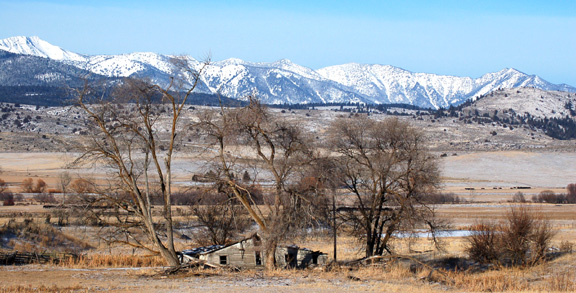Wednesday, March 19, 2008
Let's bring "Moral Hazard" Back To Wall Street
Update: Democracy now!
http://www.democracynow.org/
March 20, 2008
Fed Bailout of Bear Stearns First of its Kind Since Great Depression
. . . .
JUAN GONZALEZ: I’d like to ask Max Wolff, this issue of government oversight and regulation, people forget now that it was back in the Clinton—in the latter part of the Clinton years that Glass-Steagall was eliminated, and I think Rubin’s last act as—and also a former Goldman Sachs person, right?—his last act before he left the Clinton administration was achieving the end of the Glass-Steagall Act. To what degree did that have an effect on how these kinds of risky investment practices are jumping over into the regular banking system?
MAX FRAAD WOLFF: That’s a great question. I mean, there’s also a debate about whether that was his last act at the Department of Treasury or his first act at Citigroup, because it was Citigroup’s merger that would have been illegal had Glass-Steagall not been repealed.
AMY GOODMAN: Explain Glass-Steagall.
MAX FRAAD WOLFF: Glass-Steagall was a law put in place after the Great Depression that created what they call a firewall or a separation between investment banking and commercial retail banking, the idea being that you want to contain the potential breakout of problems in the financial system so that it can’t spread like wildfire and roughshod across different segments of the industry, more or less like it has across the different segments of the US financial industry in the last, say, ten to twelve months with absolutely devastating results, which is still ongoing. So we can’t sum up the damage done, because each day there’s more damage, a little bit like the war in Iraq. Getting a tally on the damage or cost of Iraq is impossible because it goes up while you’re trying to measure how much it went up the day before, the week before, the month before, the year before. So it’s a bit of a mess.
So, Glass-Steagall is part of an old regulatory framework that has been systematically torn down. The tearing down of that framework has allowed global financial markets to integrate, which has allowed vast savings to pour into the United States, new financial products to be innovated by Wall Street and all kinds of different financial firms, without regulation outside the core of the banking system, which built up and built up and built up and was celebrated and celebrated and celebrated as the efficiency and the genius of the free market, until, of course, with no brakes and no skid marks at the scene of the accident, it hit a brick wall.
The only thing I might add to that is I take a bit of an issue with the description that Bear Stearns was bailed out. Everybody Bear Stearns does business with was bailed out. Bear Stearns was taken out by the Federal Reserve and JPMorgan, which then served Bear Stearns’s still-warm remains to JPMorgan Chase. And they are now devouring them, and it’s being celebrated as a rescue. And for the 30 percent of all shares held by its employees, it is a devastating blow that has taken away retirement plans, hopes for the future, etc., etc. So they bailed out Wall Street—
AMY GOODMAN: Max Wolff, what’s going to happen? What should happen?
MAX FRAAD WOLFF: Well, I mean, I think it’s always tough to know exactly what’s going to happen. The way I like to do this in other lectures or my classes is to make the following point: there’s an epidemiology to this. And the discussion so far reminds me of the AIDS as “GAIDS” discussion, where we pathologize early victims as deviants who get some just punishment and pretend that it’s not a sort of pathogen entering a population where the sickest and most vulnerable fall first.
The sickest and most vulnerable people in the US money game are highly indebted, low-income consumers who tend to get subprime loans. In the journal—the mainstream journalist discussion, it sounds like there’s subprime people, like they’re born subprime in a special incubator with some kind of deformity. In fact, that’s a FICO credit score. And the poorest people get hit first and hardest by every economic disruption, because poverty means vulnerability in a market economy. So what we’ve seen in the beginning of a turndown of a long boom, a boom that really began in the early ’80s, is the weakest and most vulnerable with the most debt and the least income, the subprime crowd, hit—got slammed first, and then it sort of moves to the population, as “GAIDS” becomes AIDS becomes recognized.
And so, we’re—I think we’re in the early innings of this, maybe a third of the way through—half, if we’re lucky.
Whole transcript:
http://www.democracynow.org/2008/3/20/fed_bailout_of_bear_stearns_first
This article was just to good to pass up!
THE ECONOMY March 19, 2008
The Fed's Too Easy on Wall Street
The Fed should insist on its prerogative to strictly regulate financial institutions in boom times, not just to bail them out when it all goes bad
http://www.businessweek.com/print/investor/content/mar2008/pi20080318_697440.htm
by Chris Farrell
Booms and busts are inevitable in a capitalist system. Right now, the Federal Reserve and, belatedly, the U.S. Treasury, are out to avoid facing the terrifying prospect that the credit crunch currently bedeviling Wall Street could morph into a sharp and sickening economic downturn—or even a full-fledged depression.
Think about what the Fed has done in recent months: cut its benchmark interest rate by 3 percentage points (including a 75-basis-point easing on Mar. 18), injected massive amounts of liquidity into the financial system, set up an alphabet soup of funding mechanisms for big U.S. banks (a Term Auction Facility, or TAF; a Term Security Lending Facility, or TSLF; and a Primary Dealer Credit Facility, or PDCF), and wielded extraordinary powers to engineer the rescue of investment bank Bear Stearns (BSC).
The Fed's unusual burst of activity has a clear, specific purpose. In the jargon of Wall Street rocket scientists, the Fed wants to avoid a "fat tail" catastrophe event or "regime shift." In simpler, terms, it's trying to stop a financial-system meltdown. The Fed's urgent efforts to shore up the financial system are understandable, when depression fears have shifted from society's "crackpot fringe" to the power centers of Washington and New York. For Ben Bernanke & Co., there was no real alternative.
WHO'S RESPONSIBLE?
While Fed officials scramble to contain the damage, financial markets reel, and taxpayers get ready to foot the bill for the rescue efforts, a nagging question remains: What about the Wall Street titans who got us into this mess?
"The Federal Reserve continues to bail out major financial institutions without imposing meaningful conditions to improve their conduct and performance," complains Peter Morici, professor at the Smith Business School at the University of Maryland.
Here's a staggering figure to contemplate: New York City securities industry firms paid out a total of $137 billion in employee bonuses from 2002 to 2007, according to figures compiled by the New York State Office of the Comptroller. Let's break that down: Wall Street honchos earned a bonus of $9.8 billion in 2002, $15.8 billion in 2003, $18.6 billion in 2004, $25.7 billion in 2005, $33.9 billion in 2006, and $33.2 billion in 2007.
Those years were the heyday of the hedge fund pirate, the private equity buccaneer, the 9- and 10-figure-salary quant jock, and other financial creatures who created all kinds of complex securities and highly leveraged transactions, many of which are now coming a cropper, from LBOs to CDOs.
PAYING FOR "FREE" MARKETS
What a deal. Financiers preached the free-market gospel and pocketed unheard-of sums of money—yet when times got tough, they called for a government bailout. "Markets work if participants are at risk to both positive and negative consequences," says Raghuram Rajan, an economist at the University of Chicago Graduate School of Business and a former chief economist at the International Monetary Fund. "But on the upside, [financial firms] said, 'Hands off, don't upset the party,' and 'Don't even think of regulating us,' yet when things go the other way they say, 'We need help.'"
To be sure, not everyone has escaped unscathed. Nine months ago, Bear Stearns stock sold for $150 share. JPMorgan Chase (JPM) bought the beleaguered investment bank for $2 a share over the weekend, wiping out much of the wealth of the firm's employees.
So far that financial hit seems to be more the exception than the rule. After all, when Stanley O'Neal lost his job as head of Merrill Lynch (MER), he retired with more than $160 million in benefits and stock while Charles Prince, former CEO of Citigroup (C), left with a walk-away package worth almost $70 million.
REGULATION IS NECESSARY
In our system it's impossible to insist that Wall Street cough up the vast sums earned during the go-go years. [Is it really??? Chris] That said, when the turmoil calms down regulators should sharply step up their scrutiny of the industry, demand more transparency, and require greater accountability among financiers. The pendulum had swung too far toward "anything goes."
The President's Working Group on Financial Markets—the heads of the Federal Reserve Board, the New York Federal Reserve Bank, the Securities & Exchange Commission, and other financial policymakers and regulators—recently issued recommendations for overhauling mortgage finance (BusinessWeek.com, 3/13/08). The recommendations are certainly a good start. But much more needs to be done. For instance, "if the regulators now say that investment banks have a line to the Fed in bad times, then the Fed has to have monetary authority over the investment banks in good times, too," says Rajan.
Economist John Maynard Keynes described the essential dynamic of a capitalist economy as a struggle between the lure of financial safety, or "hoarding," and the entrepreneurial instinct, or "animal spirits." As in many other areas of life, a sense of balance is essential. We've all learned that too much deregulation unleashes an abundance of animal spirits that can be dangerous to our economic health. The trick for the men and women that guide the nation's financial affairs will be to create a regulatory regime that encourages innovation while discouraging bailouts. In that regard, a little moral hazard can go a long way.
Farrell is contributing economics editor for BusinessWeek. You can also hear him on American Public Media's nationally syndicated finance program, Marketplace Money, as well as on public radio's business program Marketplace. His Sound Money column appears on BusinessWeek.com.
http://www.democracynow.org/
March 20, 2008
Fed Bailout of Bear Stearns First of its Kind Since Great Depression
. . . .
JUAN GONZALEZ: I’d like to ask Max Wolff, this issue of government oversight and regulation, people forget now that it was back in the Clinton—in the latter part of the Clinton years that Glass-Steagall was eliminated, and I think Rubin’s last act as—and also a former Goldman Sachs person, right?—his last act before he left the Clinton administration was achieving the end of the Glass-Steagall Act. To what degree did that have an effect on how these kinds of risky investment practices are jumping over into the regular banking system?
MAX FRAAD WOLFF: That’s a great question. I mean, there’s also a debate about whether that was his last act at the Department of Treasury or his first act at Citigroup, because it was Citigroup’s merger that would have been illegal had Glass-Steagall not been repealed.
AMY GOODMAN: Explain Glass-Steagall.
MAX FRAAD WOLFF: Glass-Steagall was a law put in place after the Great Depression that created what they call a firewall or a separation between investment banking and commercial retail banking, the idea being that you want to contain the potential breakout of problems in the financial system so that it can’t spread like wildfire and roughshod across different segments of the industry, more or less like it has across the different segments of the US financial industry in the last, say, ten to twelve months with absolutely devastating results, which is still ongoing. So we can’t sum up the damage done, because each day there’s more damage, a little bit like the war in Iraq. Getting a tally on the damage or cost of Iraq is impossible because it goes up while you’re trying to measure how much it went up the day before, the week before, the month before, the year before. So it’s a bit of a mess.
So, Glass-Steagall is part of an old regulatory framework that has been systematically torn down. The tearing down of that framework has allowed global financial markets to integrate, which has allowed vast savings to pour into the United States, new financial products to be innovated by Wall Street and all kinds of different financial firms, without regulation outside the core of the banking system, which built up and built up and built up and was celebrated and celebrated and celebrated as the efficiency and the genius of the free market, until, of course, with no brakes and no skid marks at the scene of the accident, it hit a brick wall.
The only thing I might add to that is I take a bit of an issue with the description that Bear Stearns was bailed out. Everybody Bear Stearns does business with was bailed out. Bear Stearns was taken out by the Federal Reserve and JPMorgan, which then served Bear Stearns’s still-warm remains to JPMorgan Chase. And they are now devouring them, and it’s being celebrated as a rescue. And for the 30 percent of all shares held by its employees, it is a devastating blow that has taken away retirement plans, hopes for the future, etc., etc. So they bailed out Wall Street—
AMY GOODMAN: Max Wolff, what’s going to happen? What should happen?
MAX FRAAD WOLFF: Well, I mean, I think it’s always tough to know exactly what’s going to happen. The way I like to do this in other lectures or my classes is to make the following point: there’s an epidemiology to this. And the discussion so far reminds me of the AIDS as “GAIDS” discussion, where we pathologize early victims as deviants who get some just punishment and pretend that it’s not a sort of pathogen entering a population where the sickest and most vulnerable fall first.
The sickest and most vulnerable people in the US money game are highly indebted, low-income consumers who tend to get subprime loans. In the journal—the mainstream journalist discussion, it sounds like there’s subprime people, like they’re born subprime in a special incubator with some kind of deformity. In fact, that’s a FICO credit score. And the poorest people get hit first and hardest by every economic disruption, because poverty means vulnerability in a market economy. So what we’ve seen in the beginning of a turndown of a long boom, a boom that really began in the early ’80s, is the weakest and most vulnerable with the most debt and the least income, the subprime crowd, hit—got slammed first, and then it sort of moves to the population, as “GAIDS” becomes AIDS becomes recognized.
And so, we’re—I think we’re in the early innings of this, maybe a third of the way through—half, if we’re lucky.
Whole transcript:
http://www.democracynow.org/2008/3/20/fed_bailout_of_bear_stearns_first
This article was just to good to pass up!
THE ECONOMY March 19, 2008
The Fed's Too Easy on Wall Street
The Fed should insist on its prerogative to strictly regulate financial institutions in boom times, not just to bail them out when it all goes bad
http://www.businessweek.com/print/investor/content/mar2008/pi20080318_697440.htm
by Chris Farrell
Booms and busts are inevitable in a capitalist system. Right now, the Federal Reserve and, belatedly, the U.S. Treasury, are out to avoid facing the terrifying prospect that the credit crunch currently bedeviling Wall Street could morph into a sharp and sickening economic downturn—or even a full-fledged depression.
Think about what the Fed has done in recent months: cut its benchmark interest rate by 3 percentage points (including a 75-basis-point easing on Mar. 18), injected massive amounts of liquidity into the financial system, set up an alphabet soup of funding mechanisms for big U.S. banks (a Term Auction Facility, or TAF; a Term Security Lending Facility, or TSLF; and a Primary Dealer Credit Facility, or PDCF), and wielded extraordinary powers to engineer the rescue of investment bank Bear Stearns (BSC).
The Fed's unusual burst of activity has a clear, specific purpose. In the jargon of Wall Street rocket scientists, the Fed wants to avoid a "fat tail" catastrophe event or "regime shift." In simpler, terms, it's trying to stop a financial-system meltdown. The Fed's urgent efforts to shore up the financial system are understandable, when depression fears have shifted from society's "crackpot fringe" to the power centers of Washington and New York. For Ben Bernanke & Co., there was no real alternative.
WHO'S RESPONSIBLE?
While Fed officials scramble to contain the damage, financial markets reel, and taxpayers get ready to foot the bill for the rescue efforts, a nagging question remains: What about the Wall Street titans who got us into this mess?
"The Federal Reserve continues to bail out major financial institutions without imposing meaningful conditions to improve their conduct and performance," complains Peter Morici, professor at the Smith Business School at the University of Maryland.
Here's a staggering figure to contemplate: New York City securities industry firms paid out a total of $137 billion in employee bonuses from 2002 to 2007, according to figures compiled by the New York State Office of the Comptroller. Let's break that down: Wall Street honchos earned a bonus of $9.8 billion in 2002, $15.8 billion in 2003, $18.6 billion in 2004, $25.7 billion in 2005, $33.9 billion in 2006, and $33.2 billion in 2007.
Those years were the heyday of the hedge fund pirate, the private equity buccaneer, the 9- and 10-figure-salary quant jock, and other financial creatures who created all kinds of complex securities and highly leveraged transactions, many of which are now coming a cropper, from LBOs to CDOs.
PAYING FOR "FREE" MARKETS
What a deal. Financiers preached the free-market gospel and pocketed unheard-of sums of money—yet when times got tough, they called for a government bailout. "Markets work if participants are at risk to both positive and negative consequences," says Raghuram Rajan, an economist at the University of Chicago Graduate School of Business and a former chief economist at the International Monetary Fund. "But on the upside, [financial firms] said, 'Hands off, don't upset the party,' and 'Don't even think of regulating us,' yet when things go the other way they say, 'We need help.'"
To be sure, not everyone has escaped unscathed. Nine months ago, Bear Stearns stock sold for $150 share. JPMorgan Chase (JPM) bought the beleaguered investment bank for $2 a share over the weekend, wiping out much of the wealth of the firm's employees.
So far that financial hit seems to be more the exception than the rule. After all, when Stanley O'Neal lost his job as head of Merrill Lynch (MER), he retired with more than $160 million in benefits and stock while Charles Prince, former CEO of Citigroup (C), left with a walk-away package worth almost $70 million.
REGULATION IS NECESSARY
In our system it's impossible to insist that Wall Street cough up the vast sums earned during the go-go years. [Is it really??? Chris] That said, when the turmoil calms down regulators should sharply step up their scrutiny of the industry, demand more transparency, and require greater accountability among financiers. The pendulum had swung too far toward "anything goes."
The President's Working Group on Financial Markets—the heads of the Federal Reserve Board, the New York Federal Reserve Bank, the Securities & Exchange Commission, and other financial policymakers and regulators—recently issued recommendations for overhauling mortgage finance (BusinessWeek.com, 3/13/08). The recommendations are certainly a good start. But much more needs to be done. For instance, "if the regulators now say that investment banks have a line to the Fed in bad times, then the Fed has to have monetary authority over the investment banks in good times, too," says Rajan.
Economist John Maynard Keynes described the essential dynamic of a capitalist economy as a struggle between the lure of financial safety, or "hoarding," and the entrepreneurial instinct, or "animal spirits." As in many other areas of life, a sense of balance is essential. We've all learned that too much deregulation unleashes an abundance of animal spirits that can be dangerous to our economic health. The trick for the men and women that guide the nation's financial affairs will be to create a regulatory regime that encourages innovation while discouraging bailouts. In that regard, a little moral hazard can go a long way.
Farrell is contributing economics editor for BusinessWeek. You can also hear him on American Public Media's nationally syndicated finance program, Marketplace Money, as well as on public radio's business program Marketplace. His Sound Money column appears on BusinessWeek.com.
Subscribe to:
Post Comments (Atom)












No comments:
Post a Comment